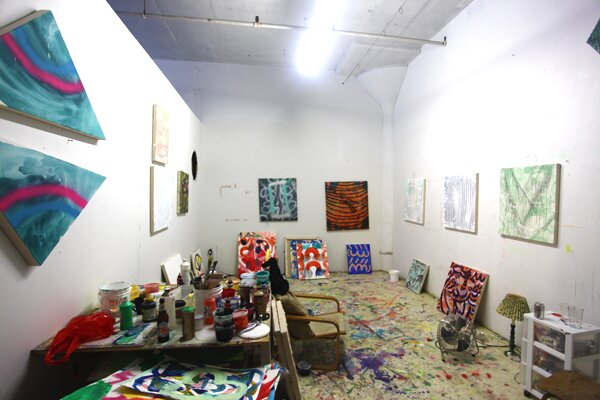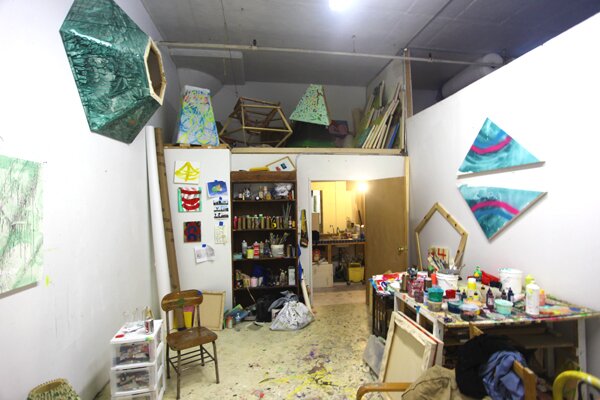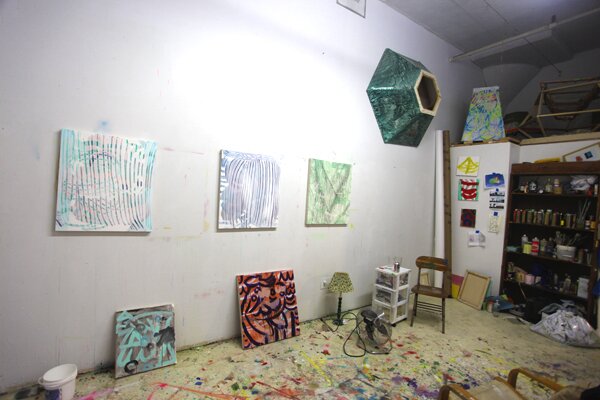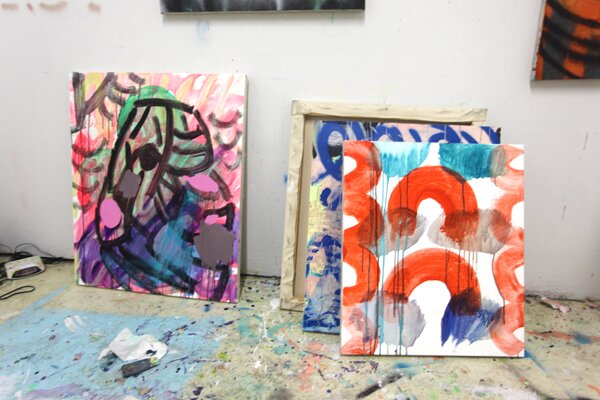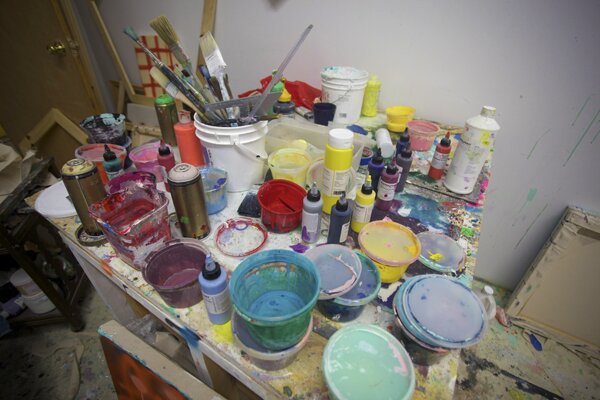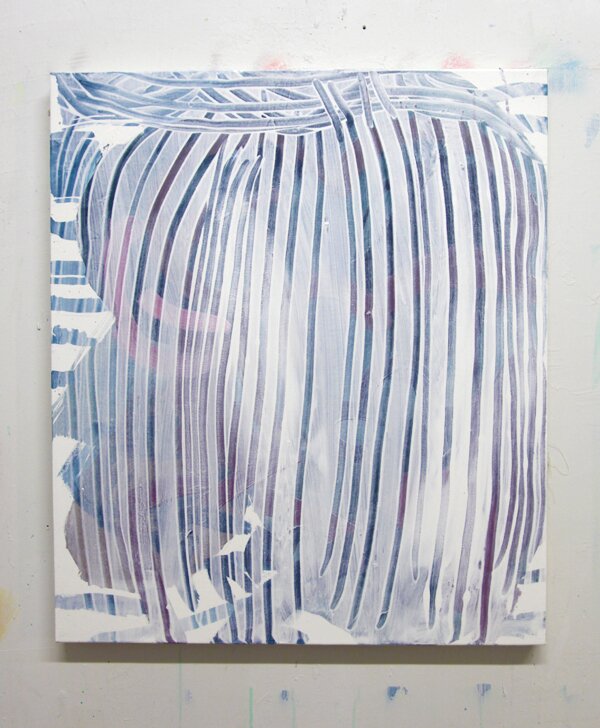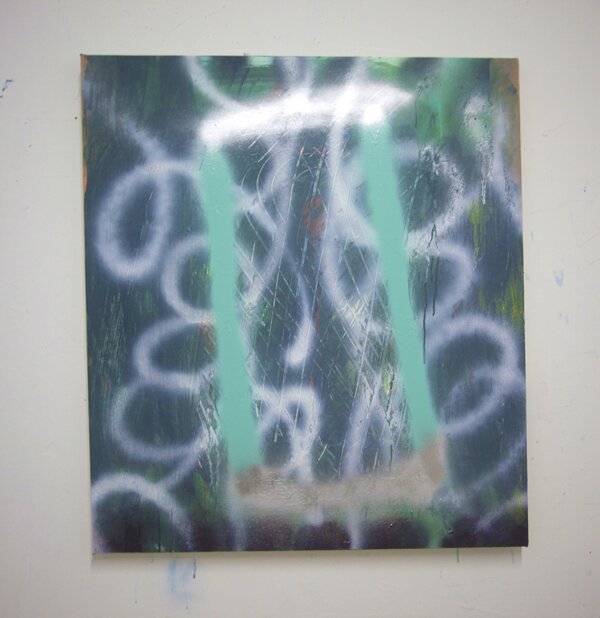is a painter that (up until recently) lived in Bushwick, Brooklyn. She graduated from the RISD’s painting department in 2009 and has shown at the Queens Muesum, Nudashank, and Freight+Volume. My interview with her took place weeks before she moved out of her studio to attend Columbia’s MFA Program.
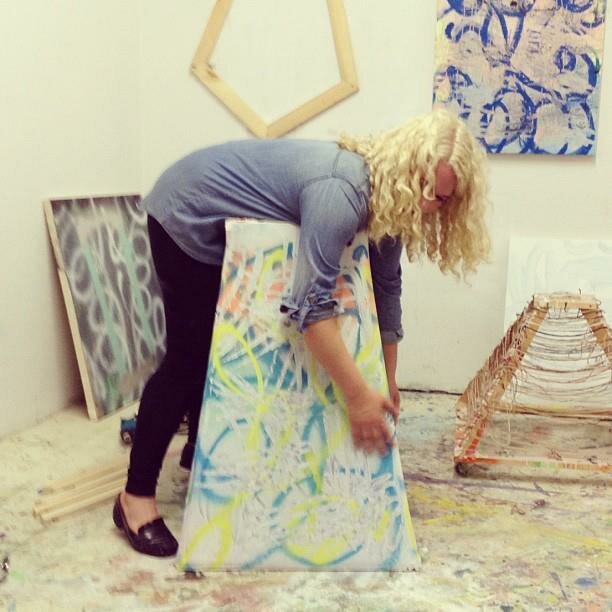 Image courtesy of Greg O’Malley
Image courtesy of Greg O’Malley
T – As you can see, I’ve been working on flat walls for the time being.
F- Why is that? Are you taking a break from your tents?
T- Yeah, I guess I have been going where the work has taken me. I’ve been having a lot of fun on the flat canvases and a speed has started to reenter my work as being an important thing. Trust me, after you spend a long time trying to put together those things [the tents], a flat canvas to me is like a piece of sketch book paper. Plus, the tents, they’re not going away. I still consider them the meat of the work that I show people but I am a little…they haven’t changed in awhile, and I don’t consider them different than the flat paintings and I always work on both usually. I never stop working on the flat paintings. I tend to work round robin. I work on everything at once.
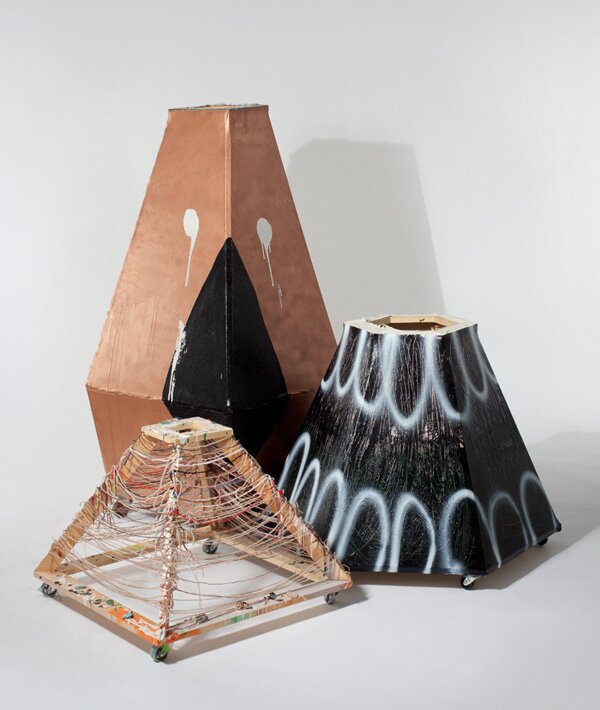 Image courtesy of Tatiana Berg
Image courtesy of Tatiana Berg
T: Every six months I like to repaint the floor.
F- Does it help make the pieces more of a piece that way?
T- Yeah, The floor is hilarious and I think every once and a while I do it. You’re able to see stuff better and when I invite other people into the studio, especially for the floor pieces, they’re against the floor and the wall, thats really important. You know how it is, after awhile your walls get really dirty and you clean them and its like “oh, I can actually see it for the first time” and so I think that that is a healthy thing. It’s funny because when I go up to other peoples’ studios I really like to see their junk and I like how their studio actually looks like they’re working, but I dont generally like to show my junk to other people. Or when I’m having an open studio I like to really clean it out and make it a presentation and I’ve had some people ask “Why are you trying to turn your studio into a gallery? That’s not what this is.” Which is making me – I dont know – Maybe Im being un-generous in the way I like to see other peoples studios but at the end of the day these paintings are so casual I almost feel they need to be grounded in something and I like to have some control over how they are viewed.
T: I was having a studio visit with someone the other day and we got to talking – he was also a painter – and we were talking about stopping a painting and knowing when it’s finished, a problem that absolutely everybody has. Especially with these guys [the paintings], some of them get really really really over-worked and that’s great – which I enjoy — and some of them can stop in two moves, like that green one over there. That whole notion of leaving openness in paintings is something I could go on and on about. How do you know when to stop? I am a chronic over do-er and I feel that if I don’t have a lot of blank canvases waiting, I’ll just ruin it cause I just want to keep going. So if I’m making this painting and I’m like if I just – say symmetrically I want to put a big green square on the left. I want to do it, but it will probably ruin it. So then I go and put that big green square on another canvas, “Oh whew I feel better!” Its like, “Uhhh redirect it!”
We were making these jokes. This is like an over-used metaphor, and I feel like I’ve used it more than once, so I don’t want to be too… It’s like painting with the pull-out method. That’s what I think about the desire to like – I like open painting more and I find it infinitely harder to do. I can do a bunch of uptight over-worked paintings like nobody’s business, but the ‘open-casual-abandoned-before-it’s-done’ type of painting I have found to be a million times harder to make. But that’s just me, and I enjoy that challenge.
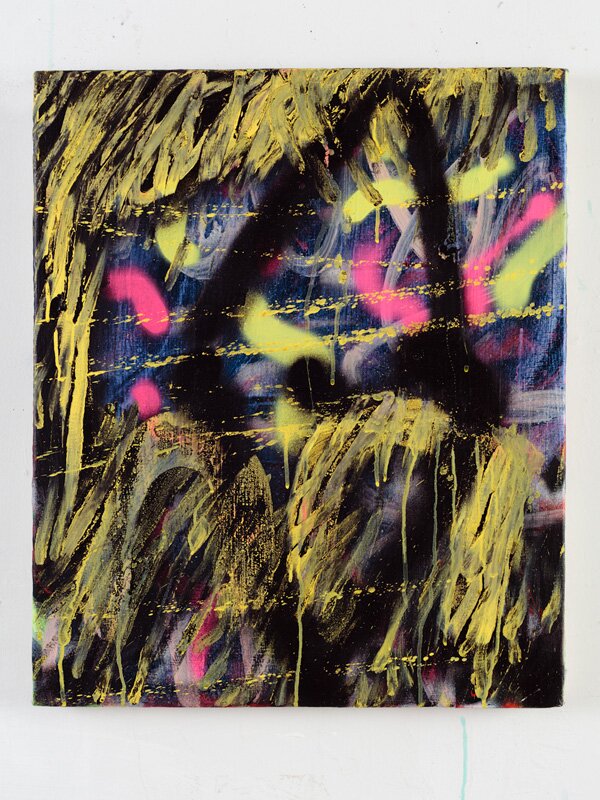 Image courtesy of Tatiana Berg
Image courtesy of Tatiana Berg
F- Do you think it’s intuitive for you to overwork your paintings and do you knowingly pull back to prevent that?
When you think is it kind of intuition now where you know your over working it you still want to keep on going you just put it away or not look at it for awhile?
T- Yeah, intuition is pretty much the only way to describe it. Turning my back on [a piece] to work on another canvas is something, but I think I just spend a lot of time looking at them for long periods of time. Sometimes I like to take them out of the room with me and look at them in natural light. And I have no problem destroying them, which has been a big help. When you’re making paintings like this I think it’s really important not to be precious about it. If it’s not working, cover the entire surface and move on. I only started to recently paint in acrylic, as much as I love love love oil paint, but that speed and the ability to easily wash every thing away has been a godsend.
Sarah Faux and I have talked about this sort of thing– I feel that my favorite paintings, or the most successful ones, are ones where a problem is slowly developed but the solution arrived at suddenly. You said something about being able to see everything that’s going on. That’s my favorite thing – like when you’re making a painting, you’re setting up some kind of problem to solve and if the problem is too easy, you end up with a boring painting. If there’s no struggle, no resistance, it’s like you’re pushing into mud. And if the problem is too hard, you fail and it gets away from you. The best ones are the ones where there’s still some element of the original problem visible and by that I mean, basically you’re able to see every decision that went into it.
In some, not everything has been obscured and then I feel … I’ve been asking myself for a long time. Why do I naturally… why am I drawn to this type of work? In other people’s paintings. And why is it that it’s this quality that I like the most in my own work? I have this feeling that it has something to do with the fact that when you look at a painting like that, you are solving the painting along with the painter in your head, and that’s so incredibly satisfying. That the only place the painting exists is in your mind, so you have a natural tendency to complete it if there is something incomplete, you want to fix it. It’s like how in contemporary tastes, people tend to prefer Renaissance sketches over really tightly finished Renaissance paintings – not to say that one is better than the other, but I feel like there’s a reason why in contemporary tastes, I would bet that more people are into that.
F: Or like if you go to see Leonardo’s sculptures, his unfinished sculptures are fantastic.
T: Oh my god yes! The dying slaves. I think those are his best ones.
F: Of course and to see that thought processes kind of a logic or vocabulary through that where you hide it – or even getting back to your work when your doing more than 5 moves for that painting then your hiding other pieces/moves. where is like 2 or 3 moves you can still kind of break through it and see these kind of like almost like half facades if you will that you can look through which is really fantastic, now that one ["Halloween Candy," 2012] which is insane! That one seems to be interesting because in some ways you have more than 5 moves there but your still able to see everything or most of everything that’s going on.
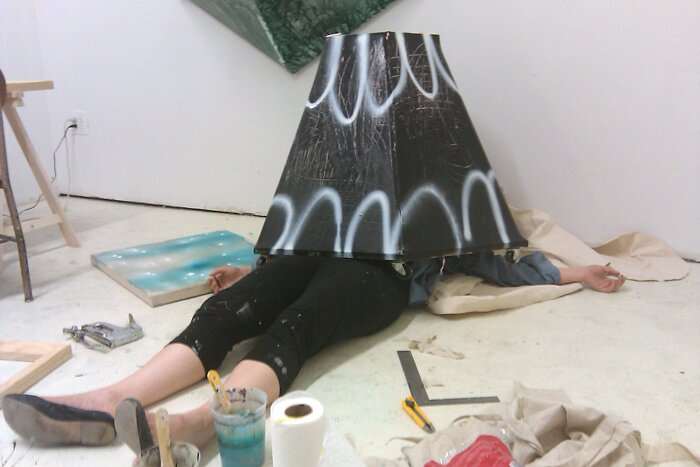 Image courtesy of Tatiana Berg
Image courtesy of Tatiana Berg
T: As layered as it gets there is still little windows into space, and maybe that’s part of why it works. I don’t know why a painting — like that one with the horizontal sagging black lines — of all these paintings that is the one that has gone through the most iterations. It’s been a lot of different paintings. There may be trace elements of it but in the end it’s like, the last thing you see is a pretty simple painting. It’s not just two moves, but the last thing I did was two moves. I put that big sort of brown glaze which sort of makes it a night-time painting, and then the horizontal spray lines, and then rested the canvas at a tilt so the bottom will seep through the top, and that was satisfying enough. I think it’s a really moody painting.
F: Oh completely. A lot more than the other ones definitely. It’s like “What happened that day” right?
T: [chuckles] I don’t know, I was having a good time making it. I say this a lot but I feel like I’m really a seasonal painter. My palette really changes. Winter, it gets really dark — it may be a little cliche but it definitely has been true for me.
F: When do you work usually, Do you work during the day or at night?
T: I’m not that much of a morning person so, I might get in here at 11. “It’s morning!” I usually work in the afternoon and evening. I’m not going to lie, I haven’t been in here very much in the past month or so. Even though it was a while ago, I still feel that the whole grad school application thing was so disruptive. I’ve been having trouble sort of making my work. For a while there I was having fun doing the flat paintings again, but right now I’m thinking about all this other stuff like moving so I can’t paint as much as I would like.
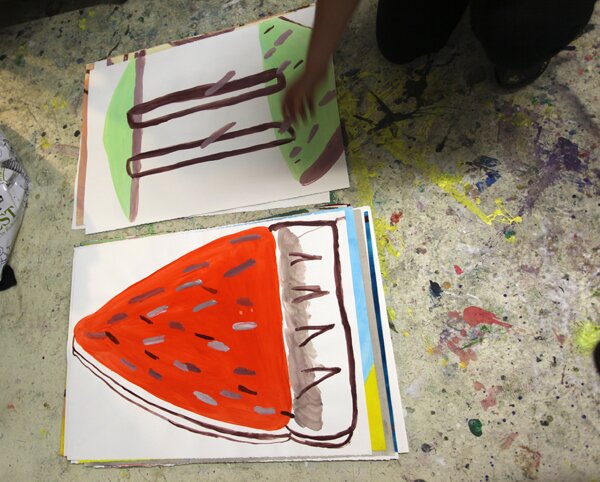
F: Do you think that’s why you are doing the flat paintings too?
T: Yes, it’s a bit less uh, I’m sure that it also doesn’t hurt the fact that it will be a little easier for me to pack up. But I really did just feel that taking a break from building those things [the tents], plus I was worried that i was repeating myself with them, that I wasn’t saying anything new. I was worried that the ones that I was making, anyone that was already familiar with my work and saw it wouldn’t get anything new out of it. I was just looking for more. I feel like with the tents there is a lot of things you can do. You can complicate the structure, you can complicate the surface, and right now I’m thinking about surfaces.
In a way with these paintings, they strive to have everything visible, so they look like they happen all at once. I think about the tents in a similar way. All the materials remain visible and so nothing is obscured, therefore it’s pretty anti-illusion. That’s one way I think about them. They will never be made out of immaculate steel or perfect edges. If they are painted on canvas you’re going to see the staples.
F: Or the gesso drips?
T: I have a lot of debate about the sides. Doesn’t everybody? Sometimes I go through the trouble of taping them and making them really clean. Right now I feel that it’s a compromise. I don’t want them to be too dirty and I don’t want them to be too clean either.
F: Right, a happy medium.
T: Maybe gesso drips, but no other drips. It doesn’t always work sometimes I get a little spray-paint on the side. When I have a thin painting I like it when the gesso has a meatiness. It makes it more object-y in a way that a thin painting needs.
F: Right, like these three right here need that materiality. It’s not lacking in that, but comparably it’s not.
T: The work on the floor is probably not done. So they might end up in a totally different place then where they currently are. They have gone through a couple different phases. Every once and awhile in a canvas work I’ve done its over so many times it’s just time to scrap it.
You can find more of Tatiana Bergs’s work at

